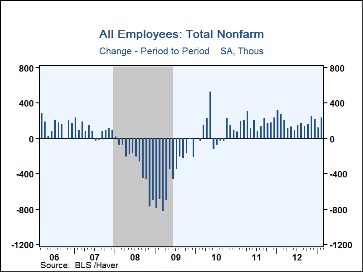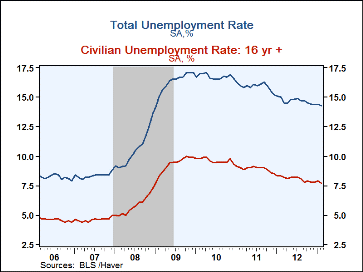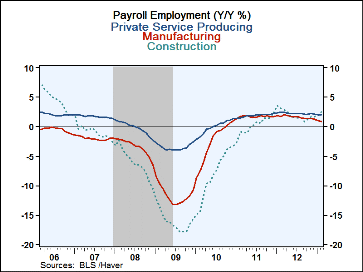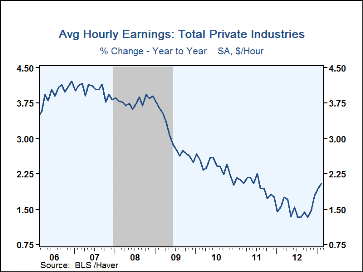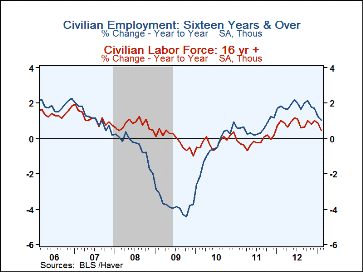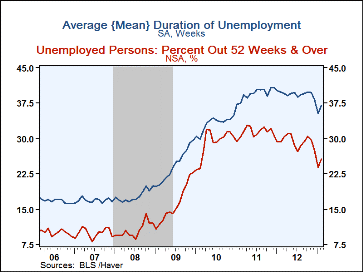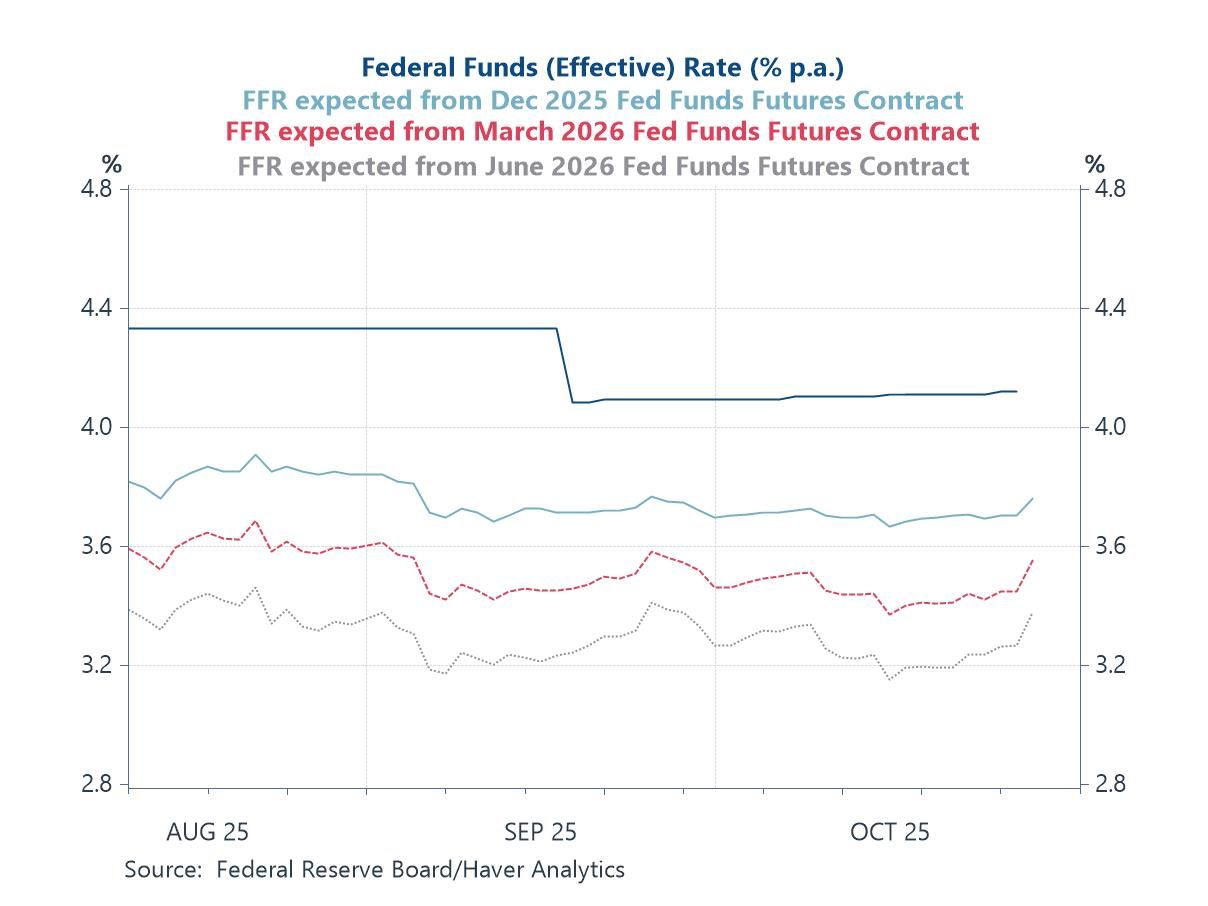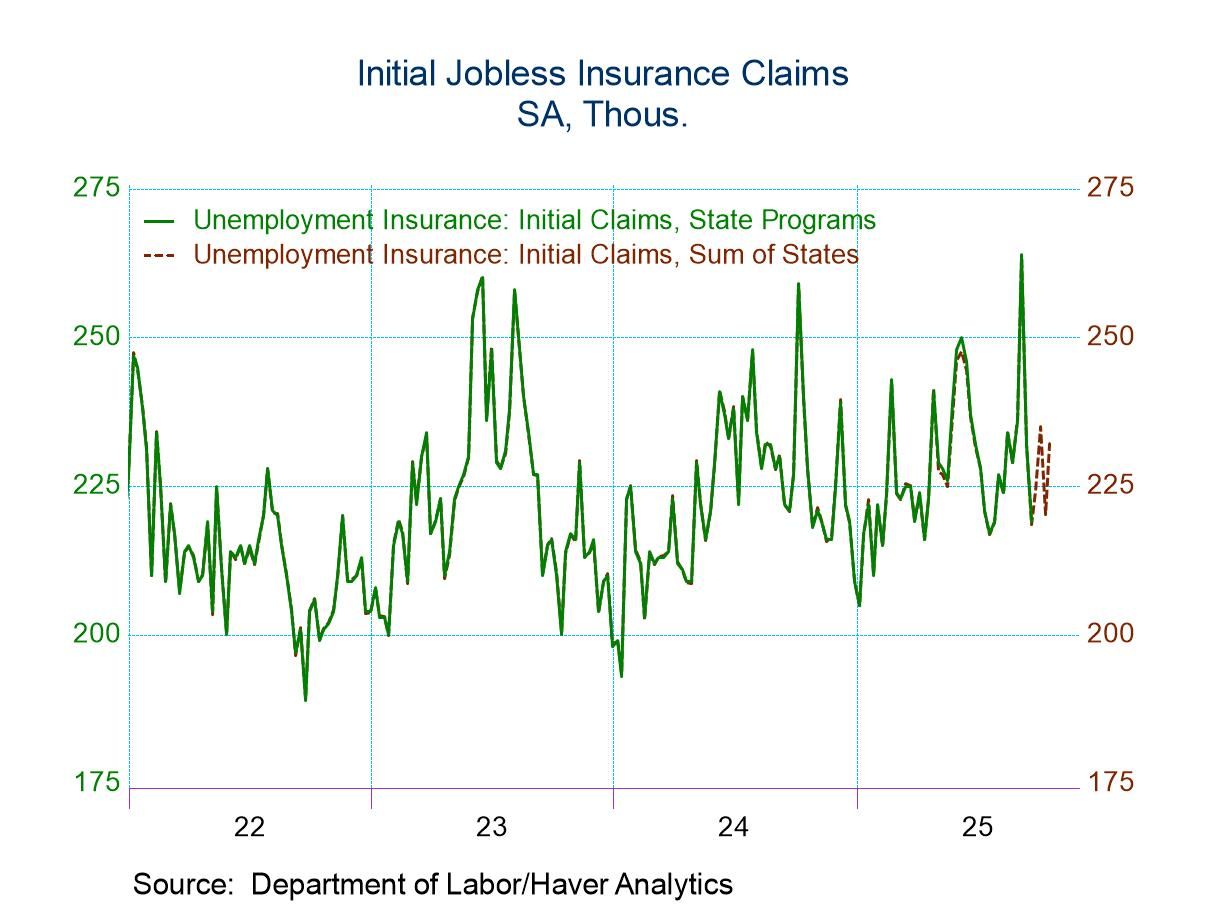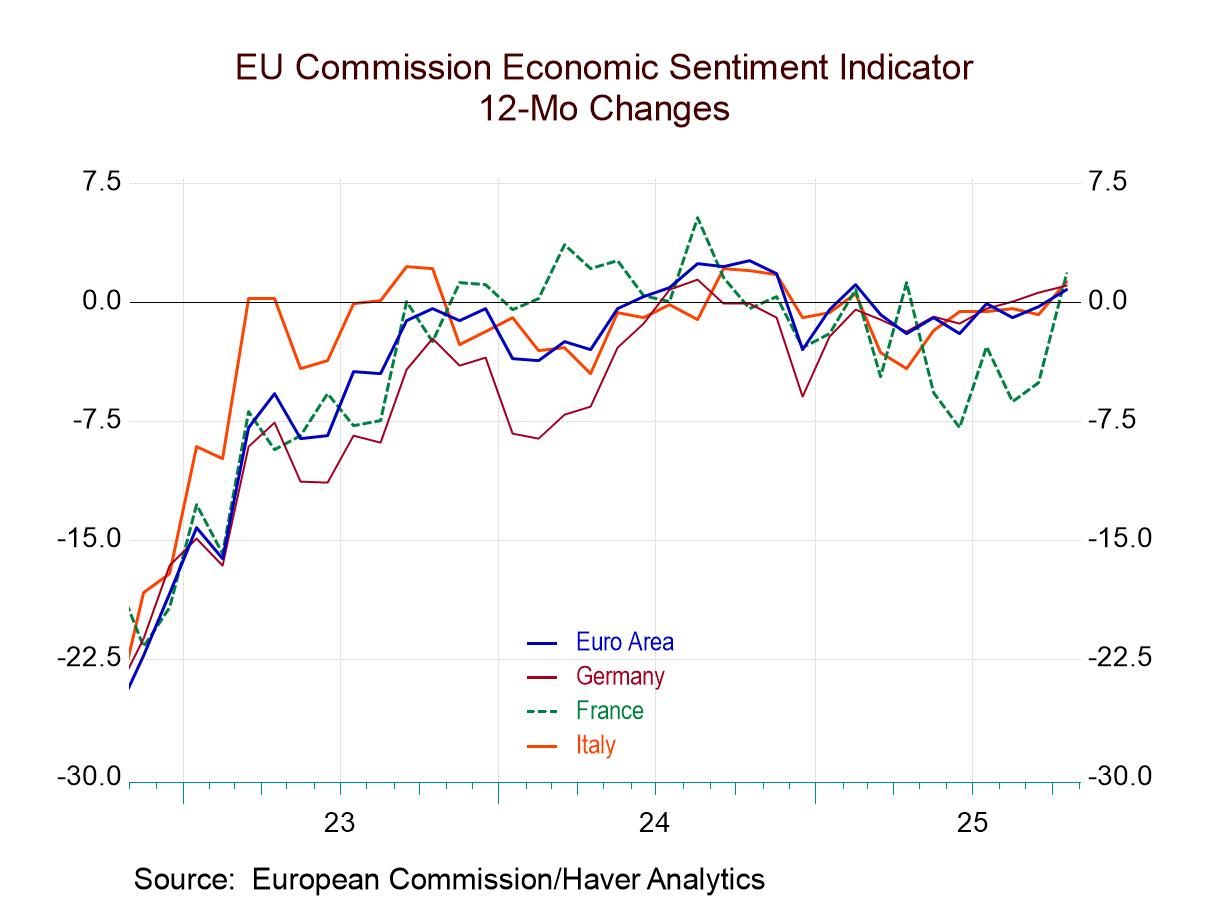 Global| Mar 08 2013
Global| Mar 08 2013U.S. Employment Jumps; Jobless Rate Reaches Cycle Low
by:Tom Moeller
|in:Economy in Brief
Summary
The rate of job market improvement picked up a bit last month. Payroll employment gained 236,000 (1.5% y/y) after a 119,000 January increase (revised from 157,000) and a 219,000 December rise (revised from 196,000). Consensus had been [...]
The rate of job market improvement picked up a bit last month. Payroll employment gained 236,000 (1.5% y/y) after a 119,000 January increase (revised from 157,000) and a 219,000 December rise (revised from 196,000). Consensus had been looking for a 152,000 increase. Job growth across industries was firm. The February unemployment rate fell from 7.9% to 7.7%, the lowest since December 2008. A 7.8% rate had been expected. The rate on the broadest measure of unemployment, which includes marginally attached & those involuntarily working part-time, slipped to 14.3%.
From the establishment employment survey, the 236,000 increase in payrolls last month was the strongest since November. Jobs in the construction sector jumped 48,000 (2.5% y/y) and factory sector employment gained 14,000 (0.9% y/y). A 179,000 worker rise (1.9% y/y) in private services payrolls powered the overall jobs gain as it recovered from a tepid 99,000 January rise. Professional & business services led the increase with a 73,000 advance (2.7% y/y). Of that, temporary help jobs gained 16,000 (4.4% y/y). Jobs in both education & health services (1.8% y/y) and leisure & hospitality (2.4% y/y) grew 24,000. Retail trade employment rose 23,700 (1.7% y/y). In the public sector, employment fell again. The 10,000 worker shortfall (-0.5% y/y) owed to an 8,000 decline (-0.6% y/y) in state and a 2,000 drop (-0.2% y/y) in local jobs. The number of federal government jobs held steady m/m (-1.3% y/y).
The length of the average workweek rose to 34.5 hours and recovered its January decline. In goods producing industries the length of the workweek jumped to 40.5 hours with the factory workweek at 40.9 hours. Total aggregate hours worked (employment time hours) rose 0.7% and pulled the Q1 average so far up 2.3% (AR) from Q4'12. During the last five years there has been a 71% correlation between the q/q change in aggregate hours and real GDP.
Average hourly earnings rose 0.3% for the fourth straight month. The 2.0% y/y rate of increase is a notable improvement from an earlier low of 1.3%. It has been led by a 2.2% y/y gain in private service-producing earnings. That owes to a 4.9% gain in financial activities and 3.8% growth in information. Education & health services earnings lagged with a 1.6% gain as did factory sector earnings, up 1.1% y/y.
Contained in household jobs survey was a drop in the unemployment rate to 7.7%, its lowest for the economic expansion. However, the decline was accompanied by another drop in the civilian participation rate to 63.5%, its lowest since early-1979. Employment rose 170,000 during February (1.0% y/y) but the labor force fell 130,000 (+0.5% y/y). The jobless rate for teenagers jumped to 25.1%. For those aged 20-24 years, it declined to 13.1% and for individuals over 25, it was a new cycle low of 6.3%. The highest unemployment rate was logged by black, male teenagers at 48.7%.
The further detail of the household survey continued to show the merits of higher education. Employment of college graduates grew 3.7% y/y while for those with some college or an associates degree it increased 0.7% y/y. For high school graduates but no college employment fell 1.4% y/y; for those with less than a high school diploma it dipped 0.2% y/y. The figures covering the length of time out of work showed that 25.6% of those unemployed had been so for a lessened 52 weeks or more. The average duration of unemployment ticked up m/m to 36.9 hours.
The figures referenced above are available in Haver's USECON database. Additional detail can be found in the LABOR and in the EMPL databases. The expectation figures are from Action Economics and are in the AS1REPNA database.
| Employment: (M/M Chg., 000s) | Feb | Jan | Dec | Y/Y | 2012 | 2011 | 2010 |
|---|---|---|---|---|---|---|---|
| Payroll Employment | 236 | 119 | 219 | 1.5% | 1.7% | 1.2% | -0.7% |
| Previous | -- | 157 | 196 | -- | 1.4 | 1.2 | -0.7 |
| Manufacturing | 14 | 12 | 13 | 0.9 | 1.7 | 1.7 | -2.7 |
| Construction | 48 | 25 | 38 | 2.5 | 2.0 | 0.3 | -8.3 |
| Private Service Producing | 179 | 99 | 166 | 1.9 | 2.2 | 1.9 | -0.1 |
| Government | -10 | -21 | -5 | -0.5 | -0.8 | -1.8 | -0.3 |
| Average Weekly Hours - Private Sector | 34.5 | 34.4 | 34.4 | 34.6 (Feb'12) |
34.4 | 34.4 | 34.1 |
| Average Private Sector Hourly Earnings (%) | 0.3 | 0.3 | 0.3 | 2.0 | 1.5 | 2.0 | 2.4 |
| Unemployment Rate (%) | 7.7 | 7.9 | 7.8 | 8.3 (Feb'12) |
8.1 | 8.9 | 9.6 |
Tom Moeller
AuthorMore in Author Profile »Prior to joining Haver Analytics in 2000, Mr. Moeller worked as the Economist at Chancellor Capital Management from 1985 to 1999. There, he developed comprehensive economic forecasts and interpreted economic data for equity and fixed income portfolio managers. Also at Chancellor, Mr. Moeller worked as an equity analyst and was responsible for researching and rating companies in the economically sensitive automobile and housing industries for investment in Chancellor’s equity portfolio. Prior to joining Chancellor, Mr. Moeller was an Economist at Citibank from 1979 to 1984. He also analyzed pricing behavior in the metals industry for the Council on Wage and Price Stability in Washington, D.C. In 1999, Mr. Moeller received the award for most accurate forecast from the Forecasters' Club of New York. From 1990 to 1992 he was President of the New York Association for Business Economists. Mr. Moeller earned an M.B.A. in Finance from Fordham University, where he graduated in 1987. He holds a Bachelor of Arts in Economics from George Washington University.


